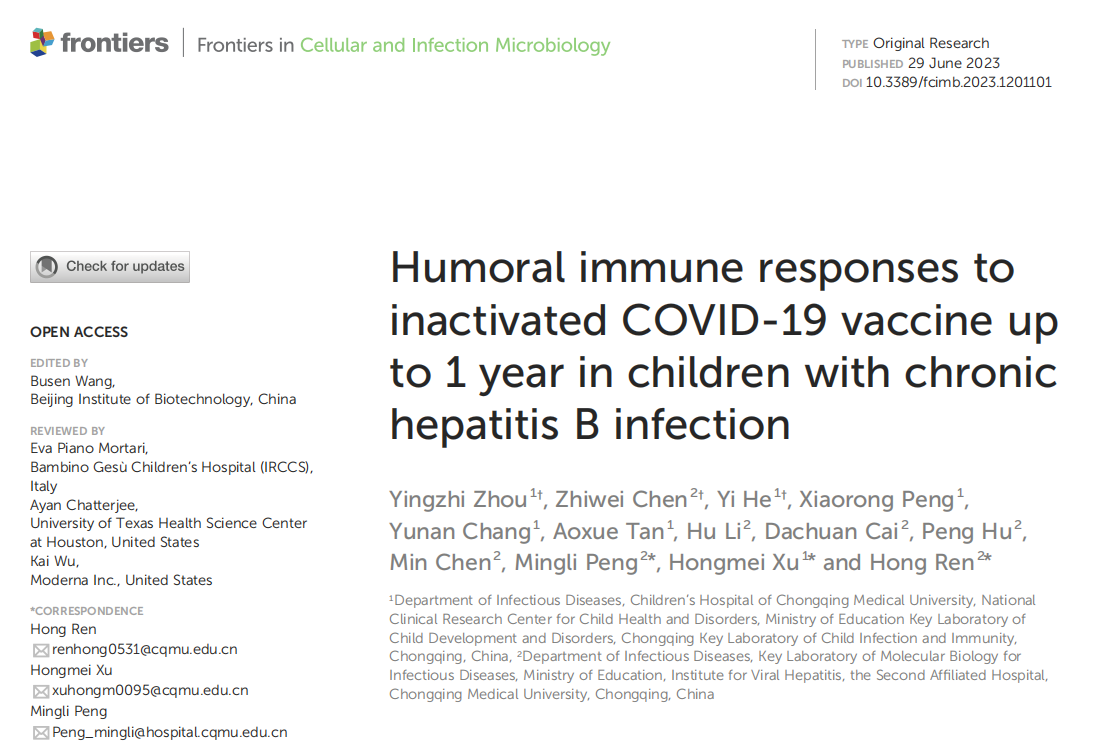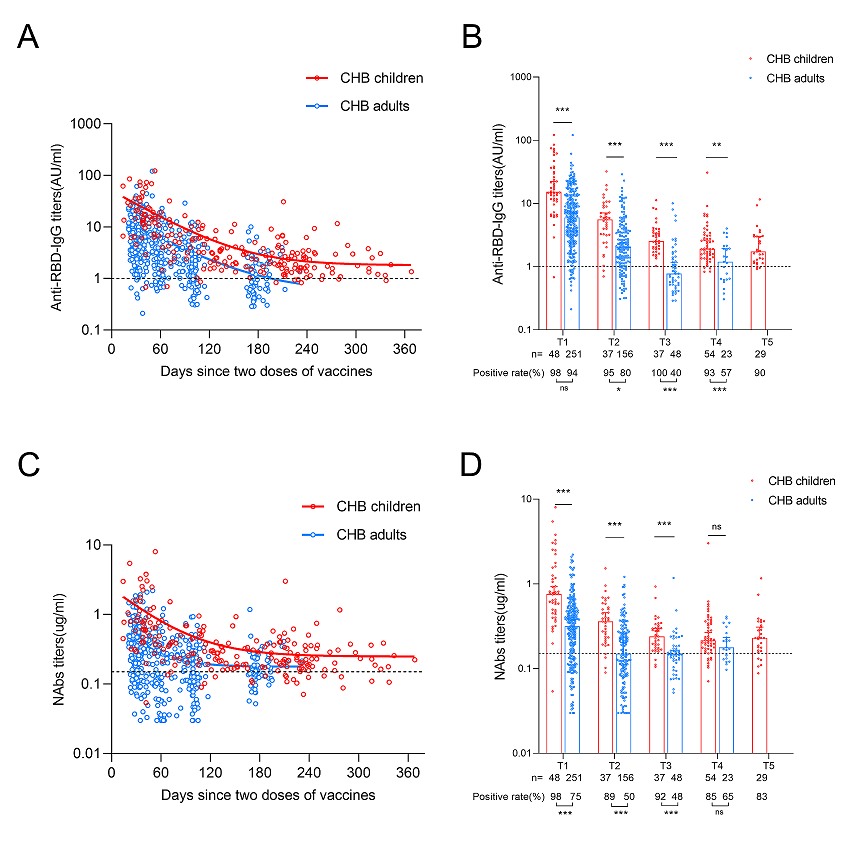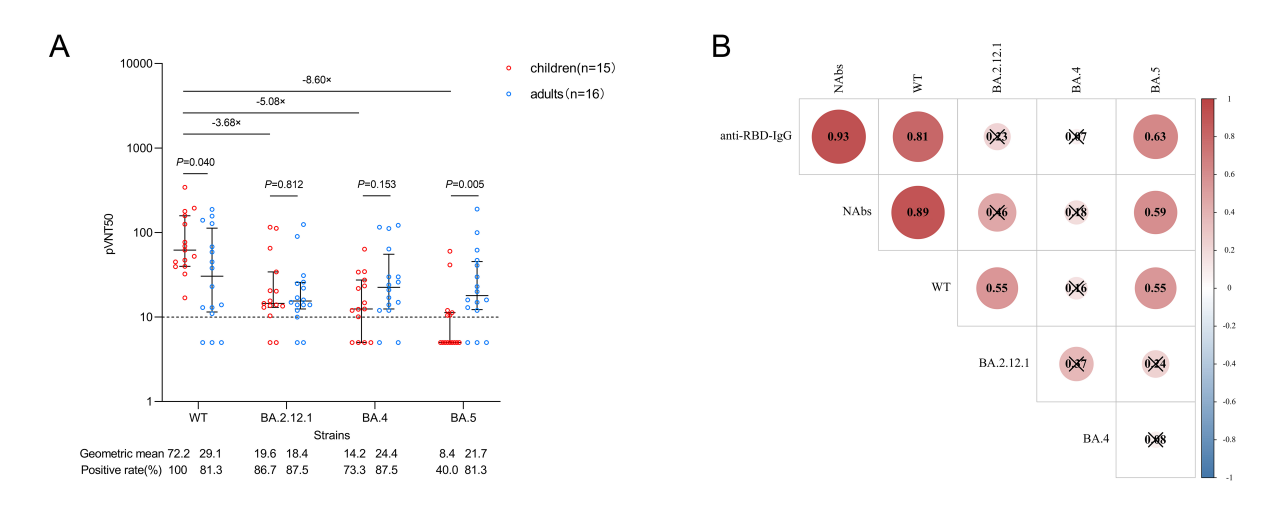
重庆医科大学附属第二医院感染病科、重庆医科大学病毒性肝炎研究所、教育部感染性疾病分子生物学重点实验室任红教授与重庆医科大学附属儿童医院感染科许红梅教授团队合作在细胞和感染微生物前沿杂志Frontiers in Cellular and Infection Microbiology(IF:6.073)以Original Article 形式在线发表了关于慢乙肝儿童接种新冠灭活疫苗后长达一年的体液免疫反应的研究结果。
在这项前瞻性观察研究中,连续招募了完成两剂新冠灭活疫苗接种的慢乙肝儿童,并对其进行了1年的随访。将另一项队列研究(NCT05007665)中的慢乙肝成人作为对照。评估了慢乙肝儿童接种新冠灭活疫苗后的RBD抗体及中和抗体水平、对Omicron变异株(BA2.12.1、BA.4和BA.5)的中和作用及记忆B细胞反应。
本研究最终纳入了115名慢乙肝儿童和351名慢乙肝成人。慢乙肝儿童的抗体滴度在接种疫苗后的前180天内下降,随后趋于平稳直至1年。而慢乙肝成人产生的抗体水平较慢乙肝儿童更低且下降得更快。有趣的是,慢乙肝儿童在接种疫苗超过8个月后仍然有很高的抗体阳性率(RBD抗体 [90%] 、NAbs [83%])。然而,慢乙肝儿童对Omicron变异株的中和作用明显降低(-3.68倍至-8.60倍)。值得注意的是,与成人相比,慢乙肝儿童对BA.5变异株的中和作用明显减弱。此外,慢乙肝儿童的RBD特异性记忆B细胞频数与成人相似,但其RBD特异性非典型记忆B细胞频数更高。
总而言之,与慢乙肝成人相比,灭活疫苗可以引起慢乙肝儿童对野生型新冠毒株更强更持久的抗体反应,但对Omicron变异株(尤其是BA.5毒株)的反应较差。因此,为慢乙肝儿童提供新的Omicron相关疫苗或一体式疫苗是有必要的。

Figure 1. Comparisons of antibody responses after primary inactivated vaccination in CHB children and adults.
(A) The kinetic changes in the titers of anti-RBD-IgG over time in CHB children (n=205) and adults (n=478). (B) The seropositivity rates and titers of anti-RBD-IgG at T1, T2, T3, T4 and T5 in CHB children and adults. (C) The kinetic changes in the titers of NAbs over time in CHB children and adults. (D) The seropositivity rates and titers of NAbs at T1, T2, T3, T4 and T5 in CHB children and adults. The plots were shown as median values with the 95% confidence interval. The dotted lines represent cut-off values. *P < 0.05; **P < 0.01; ***P < 0.001; ns, not statistically significant. anti-RBD-IgG, anti-receptor-binding-domain immunoglobulin G; NAbs, neutralizing antibodies.

Figure 3. Neutralization against WT strain and Omicron subvariants after primary inactivated vaccination.
(A) Comparisons of the neutralization against WT strain and Omicron subvariants in CHB children (n=15) and CHB adults (n=16). (B) Correlations between anti-RBD-IgG, NAbs and the neutralization. The plots were shown as geometric mean values with the 95% confidence interval. The dotted lines represent detection limit. The values of less than 10 for the pVNT50 indicate negative samples and were counted as 5. Red indicates a positive correlation between two variables, blue indicates a negative correlation, the number in each circle indicates the correlation coefficient, and the symbol “×” indicates not statistically significant. anti-RBD-IgG, anti-receptor-binding-domain immunoglobulin G; NAbs, neutralizing antibodies; WT, wild type; pVNT50, 50% pseudovirus neutralization titers.
